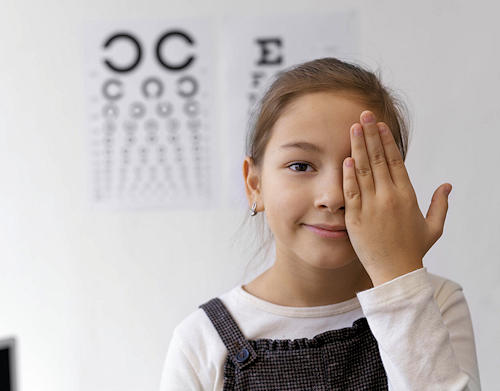
What is Lazy Eye (Amblyopia)?
Lazy eye, typically occurring in childhood, refers to reduced vision capacity in an eye without structural abnormalities in the eye or optic nerve. This condition arises from an imbalance in the brain's processing of images from the two eyes. Lazy eye usually occurs in one eye and can become permanent if not treated at an early age.The critical period, also known as 3-7 years old, is easier to treat. Therefore, children should be examined regularly from a young age, even if they have no complaints. It should be noted that it is not easy for a young child to notice reduced vision in one eye by themselves.
What are the Causes of Amblyopia?
The most significant cause of lazy eye is the difference in prescription between the two eyes. A significant difference in hyperopia and/or astigmatism between the two eyes is the most common cause of amblyopia. Sometimes, amblyopia can also occur in cases of high myopia and myopia-astigmatism.Strabismus (eye misalignment) is also a common cause of amblyopia. Continuous misalignment of one eye increases the risk of amblyopia more than when both eyes occasionally misalign. Because if only one eye is misaligned, it means the brain is not using that eye.
A less common but significant cause of amblyopia is congenital cataracts. The first year of life is the most crucial period for visual development. Therefore, all children should have an eye examination by the age of 1 at the latest.
Amblyopia can also occur due to conditions such as congenital ptosis or corneal opacity.
What Can Be Done in the Treatment of Amblyopia (Lazy Eye)?
The aim of treatment is to eliminate the cause of amblyopia and to treat amblyopia itself. The treatment of lazy eye varies depending on the patient's age, visual acuity, underlying causes, and severity of the condition.- In patients with refractive errors, the first step is to determine the correct glasses.
- In cases of strabismus, glasses may provide partial benefit, but surgery is usually required.
- In patients with cataracts, surgery is the only option.
- Surgery is also usually necessary for amblyopia due to eyelid or corneal abnormalities.
As a result, the vital three-dimensional vision (depth perception) and "contrast sensitivity," which allows us to distinguish objects more easily, are disrupted in our daily lives. In addition, disorders such as impaired hand-eye coordination and spatial orientation perception may occur. Patients with lazy eye have very little chance of success in many jobs in adult life that require depth perception.
Patching Therapy
It is the most commonly used method in the treatment of amblyopia.Studies have shown that uninterrupted patching for 3-6 hours a day during the first 7 years significantly increases visual acuity. During this time, activities such as playing computer games, watching TV up close, which provide movement, color, and light stimuli, enhance the effect of patching. Since the patched patients are of school age, at least 1 hour of reading should be added to other activities. After the age of 7, although the effect of patching does not end due to the decreased development and learning capacity called plasticity in the brain, it decreases. Drop therapy; Another option for children who do not or cannot patch is to reduce the vision of the healthy eye with drops and force the other eye to work. Although patching or drop patching can improve visual acuity, unfortunately, it does not improve depth perception and spatial perception. Some experimental drugs have been tried to achieve more effective patching or to treat amblyopia in adults, but no successful drug has been found yet.
CAM Treatment and Synoptophore
They are methods that were intensively used in the past but are less preferred today.Dichoptic Treatment
It is one of the most recent approaches in the treatment of amblyopia. It is a computer-assisted and three-dimensional treatment that has been started to be applied in recent years and works both eyes simultaneously. It can be effective even after the age of 10 in suitable patients. Its biggest advantages are developing three-dimensional vision and being more easily applicable to children who do not patch. Generally, the higher the initial visual acuity, the higher the gain. It is also used in scientific studies in children of patching age and low visual acuity.Dichoptic treatment is applied in our clinic.




